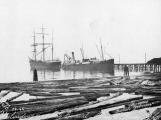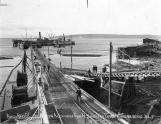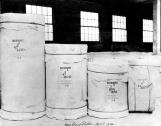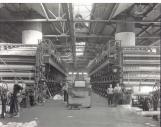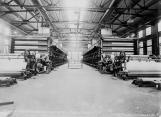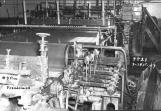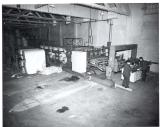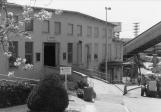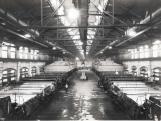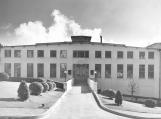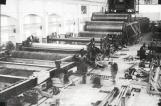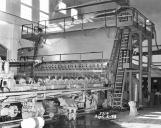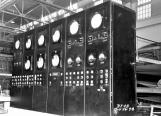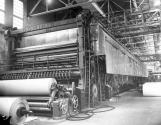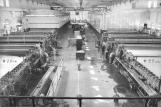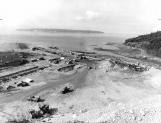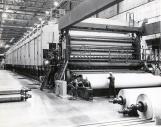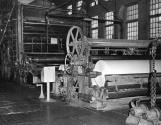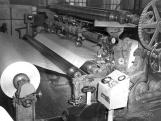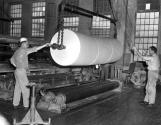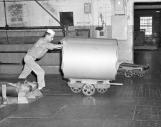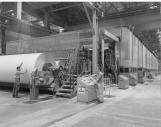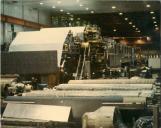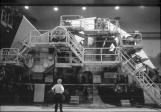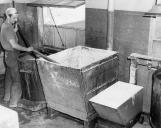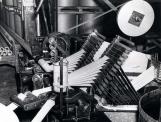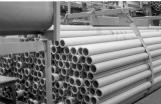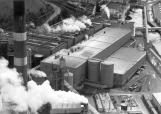

Powell River Historical Museum & Archives Association
Powell River, British Columbia
1
One afternoon, in the dying days of 1910, a large crowd of interested spectators clustered on the end of the Powell River pier. Suddenly, from one keen watcher, came a shout, "Here she comes, folks." And around the point swung into view the white sails and tall spars of a full-rigged sailing ship. It was the barque British Yeoman with the first load of concrete [cement] to arrive in Powell River--a cargo with which to lay foundations of a new industry on British Columbia's western shore line.Powell River Digester
Vol. 8, No. 5
May, 1929
3
In 1911 there was no Panama Canal. The Company's first paper machines were shipped 17,000 miles by water, around Cape Horn from New York. No. 1 was, of course, the smallest, but it was a big piece of machinery for its day. Its 32 drier rolls were each 5 feet in diameter and 12 feet 2 inches long. Overall, the machine was about 15 feet wide, 200 feet long (excluding the winder) and 11 feet high. Built by Pusey & Jones, No. 1 Machine ...........was the height of papermaking technology in 1911.5
At the end of April 1912 the first roll of saleable newsprint came off Paper Machine Number 1 and into the history books.Powell River was now the first pulp and paper mill on the west coast of Canada and a flourishing new industry had been created.
7
By May of 1912, Number 1 and 2 paper machines had been built and were producing paper. In 1913 Number 3 and 4 were in production and in 1925 an expansion for Number 5 and 6 paper machines was begun. The next expansion was in 1930 when a new building to house Number 7 and Number 8 was constructed. Number 7 began production in December of 1930 and installation of Number 8 was delayed for economic reasons. Number 8 was finally built and began producing paper in the spring of 1948.On February 28, 1957 Number 9 paper machine was started followed by Number 10 in June of 1967. The Powell River Mill now had 10 paper machines all running. Number 11 paper machine came on line in April of 1981 and by the end of the year was running at 3,510 feet per minute. When Number 1 began running nearly 70 years earlier, it ran at 660 feet per minute.
9
By February, 1913, Nos. 1 and 2 machines were producing close to capacity. Powell River was making 102 tons of newsprint daily. In April of that year, No. 3 came on line, producing another 40 tons. It was a 186-inch machine (175-inch sheet when trimmed), 32 inches wider than No. 2 and equal in other dimensions. The mill's output was increased to 142 tons a day. But that was not the end; No. 4 was completely assembled and producing by the following September, raising the plant's daily outputto 185 tons. Yearly tonnage had increased from 17,000 in 1912 to 44,000 in 1913.The B.C. newsprint market was now satisfied. For three years, it had been almost ceaseless outlay on the part of the Company. It was now time to profit from their investment.
Bill Thompson,
The Powell River Mill Story
11
(1799) in France, Louis Robert conceived the idea of using an endless wire cloth for forming a sheet of paper and sold his model and patent to his employer, Leger Didot. Didot moved to England, where, with his brother-in-law, John Gamble, they secured the help of Bryan Donkin to improve upon the original Robert model, and from their efforts the first paper-making machine ever built and operated successfully was started in Frogmore, England, in the year 1803.The following year Henry and Sealy Fourdrinier purchased the interests of Didot and Gamble in the improved Robert's machine, and Henry Fourdrinier was granted a patent on July 24, 1804, for a "method of making a machine for manufacturing paper of indefinate length."
So the machine invented by Robert, promoted by Didot and Gamble, improved by Donkin and financed by the Fourdrinier brothers became known as a Fourdrinier machine, and the same basic principles for the manufacture of paper are still in use today.
H.B. Moore,
Powell River Digester
Vol. 25, No. 1
Jan-Feb 1949
13
The cutter room is one of the important auxiliaries in the modern paper mill. Here the orders, varying in size from the small handbill to the larger sheets are made up, sorted and packed; here is cut paper for the primitive hand press, to whom rolls are useless; here, the many and widely extended demands of printer, jobber and merchant are filled.Powell River newsprint is utilized in many fields other than the daily and weekly press. Down in the cutter room, they may be making scratch pads for a merchant in one of the big coast cities, they may be turning out the pages of a telephone directory, and they may be serving as a medium for the corner grocer's weekly or semi weekly announcements. Scribbling books or scratch pads, they are all part of the daily lives of the cutter crews.
The cutter room also has the privilege of serving many newspapers in the western hemisphere. Throughout the length and breadth of the continent are many small weeklies whose circulations do not justify the establishment of the big newspaper press.
Powell River Digester
Vol. 10, No. 11
November, 1931
15
For 12 years the four machines met the demand for Powell River newsprint. Their efficiency gradually improved until 250 tons on newsprint were turned out daily and the yearly average increased to 70,000 tons.Marketing the Company's product was often difficult and uncertain. Mills in the United States were producing enough newsprint to care of their own country's demands.
Beginning in 1920, there was a huge increase in world demand for newsprint and pulp wood products. With it came a phenomenal expansion of Canada's Pulp and Paper Industry. Mills sprang up throughout the country. Canada's production of news print in 1920 was 875,000 tons; in 1929 it was approximately 1,750,000 tons.
1925 saw the beginning of the expansion for Number 5 and Number 6 paper machines. In 1926 a two-storey concrete building 541 feet long and 234 feet wide was constructed. In it were installed stock preparation equipment, two 234-inch Walmsley (221 inch trim) high-speed paper machines and roll-wrapping and labeling facilities. When the new machines were started they doubled the mill's output to 500 tons a day.
Bill Thompson
The Powell River Mill Story
17
The first of the new machines, No. 5, began making paper on June 21, 1926. The machine was powered by a Harland electric drive, complete with a separate motor-generator and an individual motor for each section. It also had a steam turbine which could drive the generator independent of the mill power supply in the event of a power shortage due to low water level in the lake. No. 5 had a fourdrinier wire 232 inches wide. It began producing paper at 500 feet per minute.The speed would be gradually increased to about 1000 feet per minute (about 11 m.p.h.)
In September 1926, No. 6 Machine, a mirror-image of No. 5, began making paper. Total mill production for October 1926 was about 11,470 tons. About 42 percent of that total was from the two new machines, which were not yet up to rated speed. By the beginning of 1928 they had raised plant daily production to 450 tons. In January 1930 the figure was 500 tons.
Bill Thompson
The Powell River Mill Story
19
In spite of greatly increased production, it was not long before the demand for Powell River newsprint again exceeded the mill's capacity and further expansion was necessary.In 1930, another building, designed to house two larger and faster paper machines, was constructed. Because of the economic conditions--"the Great Depression"--of the time, only one machine was installed.
Bill Thompson,
The Powell River Mill Story
21
No. 7 Machine, described by the Powell River Digester as the final word in newsprint machine construction, was built by Dominion Engineering. It was a 1600 ton giant with suction couch, suction presses, a removable fourdrinier to facilitate and speed up wire changing, and 52 drier rolls. Powered by a Harland sectional direct current electric drive, the machine was designed to produce a sheet 214 inches wide at 1400 feet per minute and increase daily production by 150 tons (more than the combined production of Nos. 1 and 2 Machines. On December 30, 1930, No. 7 began producing salable newssprint,..............Bill Thompson,
The Powell River Mill Story
23
The decision to install No. 8 Machine was announced late in 1946. No. 8 was the same width as No. 7. Built by Dominion Engineering Works Ltd. in Quebec, it was the first newsprint machine installed in Canada in 11 years. Most of the equipment required for it was made in Canada. No. 8 was set up beside No. 7 in the building constructed in 1930 for two identical machines.Bill Thompson
The Powell River Mill Story
25
Electronic controls which were not available to No. 7 Machine in 1930 were included in No. 8 design. The stock inlet system, developed by Powell River Company engineers after extensive discussion with operating personnel, was of an entirely new design, operating with constant level and variable pressure.Bill Thompson,
The Powell River Mill Story
27
The drier section contained 52 main driers and 10 felt driers. The Pope reel, on which the finished sheet is wound as it comes from the calender, was designed to handle enough paper for two runs through the winder, saving time in moving reels from paper machine to winder.Bill Thompson,
The Powell River Mill Story
29
No. 8 was the fastest and most modern paper machine in existence at the time. It would increase the mill's newsprint production by about 10 percent (some 25,000 tons per year) and make it the largest individual newsprint plant in the world. However, even this increased output would not meet world demand. War time conditions had limited production for several years and shortages were expected to increase.Bill Thompson,
The Powell River Mill Story
31
In 1955 the company announced the decision to install No. 9 paper machine.It was a huge project. Half a million cubic yards of earth were excavated for the building. Twenty thousand cubic yards of concrete were poured into forms requiring 2 million board feet of lumber and about 1,300 tons of reinforced steel. The building required 800 tons (300 miles) of structural steel.
Bill Thompson,
The Powell River Mill Story
33
The giant No. 9 was designed to produce a trimmed sheet 246 inches wide at speeds up to 2,500 feet per minute. It was 262 inches wide (almost three feet wider than No. 8) and 350 feet long, with 72 drier rolls weighing about 11 tons each.35
On September 10, 1962 Number 1 paper machine was shut down after the last roll came off the winder. However, the life of this machine was not yet over. It was later started up again. In 1971 both Number 1 and Number 2 paper machines were finally retired.37
The last reel from Number 1 paper machine (end of run, 1961) is run through the winder and cut to desired widths before being moved to the wrapper.39
Hoisting the last reel onto the wrapping machine.41
After nearly 50 years of continual service, the final roll from the final reel produced on Number 1 paper machine is on its way to the finishing room.43
1964: Number 10 Paper Machine.The Company announced a huge expansion including a 324-inch paper machine with 52 driers, which would dwarf the giant No. 9 beside it. On June 27, 1967 after months of meticulous training for the crews, and with amazingly few complications, "The Monster" began making newsprint.
Made by Beloit International of Canada Ltd. in Sorel, Quebec, the Machine, Powell River's No. 10 was the largest in the world. It was designed to run at 3,000 feet per minute and was equipped with a data recording system that could be linked to computer. Number 10's 160,000 tons annual output boosted the Powell River mill's yearly newsprint output to 692,000 tons, keeping it in first place as the world's largest single-unit producer. It increased MacMillan, Bloedel and Powell River Company's production to over a million tons a year. In March 1973 No. 10 was operated at 3,000 feet per minute and 300 inch trim continuously for 48 hours, setting a Canadian record.
Bill Thompson,
The Powell River Mill Story
45
It was designed to run at 3,000 feet per minute and was equipped with a data recording system that could be linked to computer. Number 10's 160,000 tons annual output boosted the Powell River mill's yearly newsprint output to 692,000 tons, keeping it in first place as the world's largest single-unit producer. It increased MacMillan, Bloedel and Powell River Company's production to over a million tons a year. In March 1973 No. 10 was operated at 3,000 feet per minute and 300 inch trim continuously for 48 hours, setting a Canadian record.Bill Thompson,
The Powell River Mill Story
47
The new machine is 302 ft (92 m) long, some 60 feet shorter than conventional paper machines that were operating at 3,000 fpm. Designed to run at 3,500-4,000 fpm, No. 11 would have to dry the sheet even faster, but with a shorter drier section. The drier section was interrupted before the final 8-roll segment by a roll breaker calender stack, which began the calendering process before the sheet entered the final drying stage. The new Monster began turning out newsprint at 3,100 feet per minute in April 1981.49
#11- Into the Startup ModeAs far as #11 is concerned, we are presently in the startup mode. In the week of January 19, we started flushing and checking out equipment on the wet end, working toward the dry end. We anticipate getting into the checkout of the machine itself shortly, and flushing the lubrication system.
The whole stock preparation area is broken down into small systems, and we are flushing them one by one. We're looking for any problems with leaks or mechanical problems with pumps. When the problem areas are found, a crew comes right behind and rectifies them. We've been checking the drives for the machines over the past few weeks as well.
The month of February will be hectic. We have to complete the unfinished work, and finish the complete checkout of the systems by mid-march. Approaching fast is stage three of the checkout--when the operators actually have their hands on. This could be ready to occur on some systems by the third week of February.
Powell River Penstock
Vol. 5, No. 1
March, 1981
Historical Note:
By the end of the year, No. 11 was the fastest paper machine in Canada, running at 3,510 feet per minute (a mile of paper every 90 seconds, or 40 miles per hour). In August 1983 it set a world record for one month's production. In 1985 the big machine was rated the best in the world. No. 10 made the world's top ten.
51
Dextrine Glue and Its PreparationBy Hudson Pirie
A lot of you no doubt have seen the big cans of brown, syrupy looking glue we use in the Finishing Room for applying the wrappings on the roll of newsprint. Have you ever stopped to think just how and what glue is made from?
There are many and various kinds, too numerous to mention, but as we use a large amount of what is known as "dextrine" glue, lets see just what kind of stuff it is. The original form of this glue is - believe it or not - corn.
In initial manufacture, the corn, after being mixed with an acid to make it more soluble, is heated to about 235 degrees F., and when dried, is ground into powder form and put into sacks in which form it is received here.
In preparing this type of glue for use, an alkali is usually added along with various ingredients to make the dextrine stickier and faster drying, borax and caustic flakes being used here. The caustic about 3 pounds and borax 35 pounds is mixed in a large steel drum in a small amount of water.
The drum is then filled with water and 200 pounds of dextrine added. Steam is then injected which heats and breaks up the ingredients, while being stirred continuously. This makes up a batch of 660 pounds. After cooling the glue is then ready for use.
Men and Paper
Vol. 1, No. 46
March 29, 1947
53
Core Roll Machine Attracts VisitorsBy Hudson Pirie
After the core stock rolls are manufactured during a wrapper run on one of the paper machines, they are cut up on a rewinder into strips or bands 4 inches wide and about 30 inches in diameter, 12 strips in width per roll.
These rolls are then broken down at the core machine into the individual strips and cleaned, then placed on spools on a rack which holds about 25 of these strips. A standard core will run about 20 of these at one time during the manufacture. The strips are run through a bath of glue and finally met, one on top of the other, on a steel core or shaft coming off in a spiral formation. The strips are kept tight by belts running over the outside bands to insure good adhesion.
The cores come out of the machine into a trough which keeps the core running straight until it reaches a length of 72 ft. when an automatic stop cuts the power and the core is cut off. These cores are piled in a rack holding about 300 finished lengths through which warm air is circulating at all times to ensure thorough drying. The cores are moved every day to make sure the oldest ones are used first. These long cores are cut into the required or programmed length by a "core cutter" using a special ground saw which makes a clean cut, free of ragged edges, which might interfere with the winding.
Men and Paper
Vol. 1, No. 29
November 30, 1946
55
An interview from the Finishing RoomI've heard stories of people who stuck messages or cartoons in the cores. Did you ever hear of anyone communicating that way?
"Oh ya, those things were going on. You could see how the messages people stuffed into the cores were lost; because once the roll got to a newspaper, before it was used the ends were cut off straight away and thrown out, and that's where the messages were hidden."
"All this stuff went all over the world. We used to have a little thing they started out, where they finished the paper, put the wrapper on them and get them ready to ship out, it was called the snooze can news, and in those days a lot of the guys chewed tobacco in there. They'd clean out the snooze can, then they'd stick it in the core of the roll, put the plugs in, then when it got to where it was going, the guys would be punching the lip plugs out of the cores, and out would come this can, and they'd open it up there'd be a little write up about what was going on, and then they started sending things back. That went on for quire a few years there. People got to meet people in other parts of the world through that sort of thing."
Transcript of interview tape
People of the White City
57
The Company's Penstock magazine of February 1979 announced a $163 Million Investment for Powell River which would increase the mill's paper production by 193,000 tonnes, bringing the Company's total annual newsprint capacity (including Port Alberni mill) to 1.4 million tonnes. Bruce Howe, Company Vice-President, said No. 11 Machine was expected to be profitable, productive and competitive in cost, paper quality and technology into the 21st century. It was the first major expansion of B.C.'s newsprint industry in 10 years and was expected to provide about 100 permanent jobs and make the mill more efficient by making better use of each log. Other newsprint producers in B.C. and United States had already announced plans to increase capacity.By April the project was well under way, employing some 100 workers-increasing to 500 by the following spring and eventually to 700. Premier Bill Bennett officially started the work by using a front-end loader to dump a load of dirt into a truck.
No. 11 Paper Machine, a 300-inch-trim Bel Baie model from Benoit Canada Ltd., was the largest part of the expansion program, which included a new core-manufacturing plant, using modern computer and laser technology, and two new, Canadian-made TMP lines of improved design. Total TMP production would increase to 750 tonnes per day. A new 60-megawatt electrical substation would supply power to the TMP lines. The new paper machine and TMP lines were housed in steel-framed structures adjacent to Nos. 9 & 10 Machines. New finishing facilities for Nos. 9-11 Machines were required, as well as a new warehouse of 3,000 tonnes capacity to handle the increased production.
The Powell River Mill Story,
Bill Thompson, 2001
